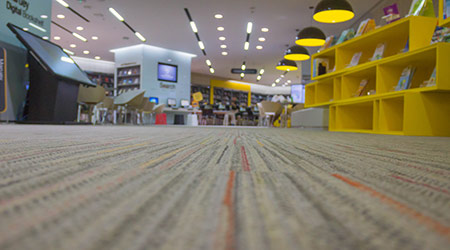
Routine maintenance can prolong the life and appearance of carpets, but excessive moisture can quickly negate the cleaning process. Not only do wet carpets act as a magnet for dirt, but they pose potential health and safety risks to building occupants, which is why drying carpets is as important as cleaning them.
"Water is the foundation of life and a universal solvent, so it's a good thing — unless it sits in your carpet," says Allen Rathey, principal of the Health Facilities Institute, Boise, Idaho. "When that happens, you could be creating an artificial environment for microbes and mold to grow, and that could be harmful to humans."
When using low moisture cleaning methods, carpets typically dry in less than an hour. In contrast, hot water extraction methods use more water to deep clean carpets, resulting in longer dry times. For this reason, distributors often recommend truck-mounted systems to remove the maximum amount of dirt and water. When done correctly, the extraction process should leave carpets dry in four to six hours.
Reducing Risks
If carpets are damp or musty smelling after 24 hours, facility cleaning managers may need to troubleshoot the problem. Is faulty equipment to blame? Are custodians using the equipment correctly? Is the cleaning method conducive to the type of carpet fibers being cleaned?
"People tend to over-wet the carpet, which causes wicking and drying problems," says Bill Griffin, president of Cleaning Consultant Services Inc., Seattle. "You need to understand how much moisture to put down, what type of carpet you're cleaning and how to adjust the temperature and pressure of your machinery."
Prepping the carpet before cleaning it is equally important. Managers should train technicians to use a vacuum cleaner and pile lifter to remove as much dry soil as possible from the carpet. This will reduce the number of wet passes needed during the cleaning process.
According to John Poole, a consultant with the American Institute of Cleaning Science in Atlanta, over-wetting carpets is more likely to occur when using a rotary machine, particularly if the technician is poorly trained. When this happens, he suggests using a wet/dry vacuum to remove excess water.
"A wet/dry vac is a handy tool to have if you're not using an extractor," he says. "It provides that extra level of care to ensure that you're getting any excess moisture out of the carpet."
Outside the realm of routine carpet care, wet/dry vacs are useful for responding to emergencies, such as spills, when it's imperative to remove excess water or liquid as quickly as possible. Poole recalls an occasion when a gallon of sesame oil spilled in an elevator.
"People were stepping off the carpet in the elevator onto a marble floor and slipping and sliding," he says. "Departments have to be ready to deal with any emergency. If you don't have an extractor, use a wet vac for spills, and then cover the area with a safety tent so people know it's wet."
Even carpets that are damp after regular cleanings can increase the risk of slip-and-fall injuries.
"When you transition from a carpet to a hard surface floor, you need to have wet floor signs up," notes Poole. "I've fallen and injured myself coming from a wet carpet to a break room with a vinyl tile floor. You may think the carpet is dry, but unless you've felt it, you don't know for sure."
Griffin agrees, adding that the longer you can keep people off wet carpeting the better.
"Plan your cleaning so you don't risk having a lot of foot traffic on it," he says. "Don't clean in the middle of the day; clean on a Friday night or a holiday when you know the building will be unoccupied the next day."
Techniques To Speed Up Carpet Drying

 The Down and Dirty on Cleaning in Virus Season
The Down and Dirty on Cleaning in Virus Season How Surfactant Use is Expanding in Commercial Cleaning
How Surfactant Use is Expanding in Commercial Cleaning Maximize Your Margins: Learn How to Automate Pricing and Track Rebates
Maximize Your Margins: Learn How to Automate Pricing and Track Rebates